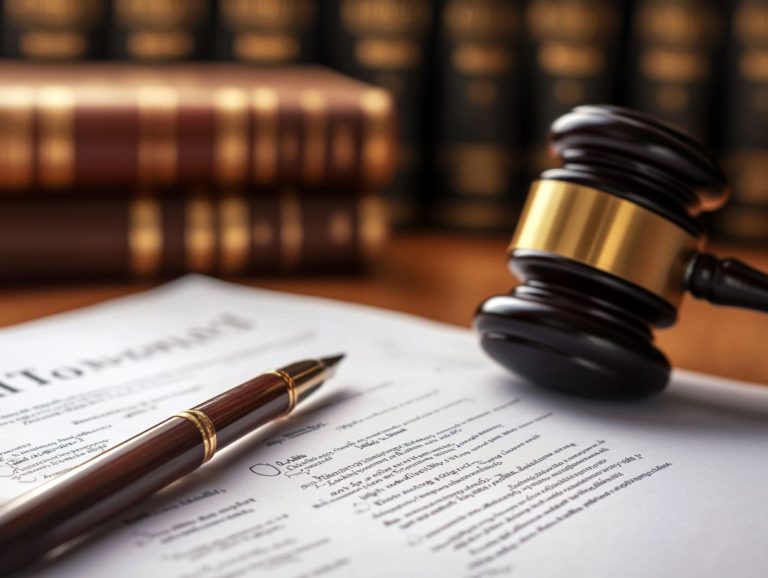5 Myths About Licensing Agreements You Need to Know
Licensing agreements can unlock various benefits for your business. However, many misconceptions often prevent people from reaping these rewards.
Whether you are a small business owner or an aspiring entrepreneur, understanding these agreements is vital. This article demystifies five common myths that may be holding you back.
Discover what licensing agreements really are, the advantages they provide, and how to navigate them effectively. Understanding these concepts can empower your business decisions!
Contents
- Key Takeaways:
- 1. Licensing Agreements Are Only for Big Companies
- 2. Licensing Agreements Are Only for Intellectual Property
- 3. Licensing Agreements Are One-Size-Fits-All
- 4. Licensing Agreements Are Only for Products
- 5. Licensing Agreements Are Not Necessary for Friends and Family
- What Is a Licensing Agreement and How Does It Work?
- Frequently Asked Questions
Key Takeaways:

1. Licensing Agreements Are Only for Big Companies
Licensing agreements are not just for large corporations. They play a crucial role in art licensing, allowing artists and small businesses to protect their creative rights.
These agreements connect independent creatives with manufacturers and retailers. This collaboration helps businesses offer unique products in a crowded market, enhancing their competitive edge.
Maintaining originality is vital. Fair licensing terms ensure artists receive recognition and compensation for their work.
This partnership fosters creativity and supports a thriving ecosystem where innovation can flourish.
2. Licensing Agreements Are Only for Intellectual Property
Licensing agreements extend beyond just intellectual property. They are essential for artists and businesses to obtain permission for using creative works.
Understanding these agreements is crucial. Not having the right licenses can lead to legal issues that stifle your creativity, so be sure to avoid common mistakes in licensing agreements.
Legal advice can help you navigate these complexities. This guidance is key to protecting your work and maximizing your commercial potential.
With the right steps, you can avoid infringements and boost your work’s impact.
3. Licensing Agreements Are One-Size-Fits-All
Licensing agreements are not one-size-fits-all. Every artist and business has distinct needs that require tailored agreements.
Different industries, like fashion and film, need specific licensing terms. For example, a photographer may need particular conditions for how their images are used.
Keeping compliance records is vital. These documents ensure all parties meet their obligations and can adjust terms as needed.
Such flexibility allows agreements to adapt to changing markets and evolving artistic visions.
4. Licensing Agreements Are Only for Products

While licensing agreements are often thought of in the context of tangible products, their scope extends far beyond physical items. They are crucial for the licensing of artistic content, allowing brands to cultivate valuable partnerships and effectively utilize licensed artwork across an array of platforms and media.
Take digital media, for example. These agreements enable the seamless integration of artistic work into video games, social media campaigns, and even e-learning materials. This significantly enhances the user experience.
In advertising, licensed art can elevate your marketing strategies by connecting your product with popular cultural symbols. This captures the attention of diverse audiences.
Packaging benefits from licensing too, as it incorporates beloved imagery that resonates with consumers. This makes your products more attractive.
By leveraging these collaborations, your company can greatly expand its market reach and develop a stronger brand identity. Ultimately, this leads to increased sales and heightened consumer engagement.
5. Licensing Agreements Are Not Necessary for Friends and Family
The notion that licensing agreements are unnecessary when sharing artwork with friends and family can lead to some serious legal missteps. Copyright protections, which prevent unauthorized use of creative work, are universal.
Neglecting to secure the proper permissions can create significant issues down the road. This misunderstanding can strain personal relationships, as individuals may unwittingly infringe on an artist’s rights.
It’s essential to grasp that even casual sharing whether online or offline can violate copyright laws if permissions haven’t been obtained first. The concept of fair use, often seen as a handy loophole, comes with specific limitations.
It does not universally permit the redistribution of artistic content. By appreciating the importance of obtaining consent and honoring creators’ rights, you can cultivate a culture of appreciation instead of stumbling into unintentional legal conflicts.
What Is a Licensing Agreement and How Does It Work?
A licensing agreement is a legally binding document that grants you permission from the original creator of artwork or creative work. It outlines the terms of use, the rights granted, and any limitations.
This document acts as a vital tool for protecting creative rights while unlocking a range of licensing opportunities. These agreements are essential in ensuring that you, as a creator, can monetize your work without giving up ownership.
They effectively establish a framework that governs how the creative work can be utilized. Typically, you ll find key components like duration, scope of use, and compensation clearly defined, which highlight the obligations of both you, the licensor, and the licensee.
As the licensor, you must safeguard the integrity of your work and enforce the terms laid out in the agreement. Meanwhile, the licensee is tasked with adhering to the limitations specified.
This balance of rights and responsibilities fosters a mutually beneficial relationship, paving the way for innovation and growth across various industries.
What Are the Different Types of Licensing Agreements?
Various types of licensing agreements are available, each designed to meet specific needs and unique scenarios in the realm of artistic content licensing. You have options like exclusive and non-exclusive licenses, IP licensing, and agreements for derivative works.
These agreements cater to a variety of situations, such as collaborative projects, adaptations, and distribution rights, giving you the power to strategically leverage your creative work.
The importance of keeping detailed compliance records cannot be overstated; they not only serve as proof of adherence to contractual obligations but also play a crucial role in shaping the dynamics of licensing negotiations.
A well-maintained compliance record enhances your credibility during discussions, potentially leading to more favorable terms. This assures all parties involved of lawful usage and mutual respect.
By thoughtfully navigating these elements, you can cultivate more productive relationships within the licensing landscape.
What Are the Benefits of Entering into a Licensing Agreement?

Engaging in a licensing agreement presents numerous advantages, including the opportunity to earn rewards for your creative work, increase your licensing revenue, and build valuable partnerships with brands and businesses.
These agreements can yield significant financial benefits; you earn a percentage of sales from products featuring your designs or music. For example, imagine collaborating with a leading apparel brand to launch a limited-edition clothing line that showcases your unique style while expanding the brand’s audience.
Licensing can supercharge your brand’s visibility! It allows you to reach new markets and audiences. Consider a popular singer teaming up with a beverage company; these partnerships can spark innovative campaigns that elevate both your profile and the brand’s identity.
Ultimately, these alliances do more than generate income; they inspire creativity, leading to new ventures and projects that benefit everyone involved.
What Are the Key Elements of a Licensing Agreement?
Key elements of a licensing agreement include the copyright status of the artwork, the quality of the artwork, seller information, and the specific rights granted. These aspects are crucial for ensuring that both parties understand their obligations and protections.
These components lay the groundwork for a transparent relationship between you, the artist, and the licensee. Clarifying copyright status prevents legal disputes down the line, while quality assurance ensures that the licensed work meets required standards.
Seller information provides essential contact details and establishes your credibility as an artist, fostering trust. Outlining specific rights granted for example, usage limitations and duration is vital for defining what the licensee can do with the artwork, thus safeguarding both parties’ interests.
How Can a Business Protect Itself in a Licensing Agreement?
To safeguard your interests in a licensing agreement, prioritize legal counsel, implement strong copyright protections, and maintain detailed compliance records to reduce risks associated with potential infringements.
Establishing clear terms within the agreement helps outline the rights and responsibilities of both parties, significantly lowering the risk of misunderstandings. Incorporating clauses that specify dispute resolution and provisions for regular audits further ensures adherence to agreed-upon standards.
Staying informed about evolving laws affecting your licensing strategy is essential, as is training your employees on compliance importance. Addressing these elements proactively can strengthen your position and significantly reduce the likelihood of costly litigation or reputational damage.
What Are the Common Mistakes to Avoid in Licensing Agreements?
Common mistakes in licensing agreements can lead to a maze of legal issues. Failing to verify copyright status, neglecting to define the scope of use, and inadequately protecting intellectual property are all missteps that underscore the need for informed decisions throughout the process.
These oversights not only jeopardize creative rights but can also strain relationships between artists and businesses, creating an atmosphere of distrust. For instance, if the scope of use is vaguely defined, it leads to disputes over how the licensed material can be used, resulting in unnecessary friction and confusion.
Clear communication is essential from the outset. Ensuring all aspects of the agreement are thoroughly discussed and documented fosters mutual understanding, paving the way for a more productive partnership and improving teamwork while minimizing risks.
Seeking legal advice before finalizing agreements can be invaluable in navigating these complexities and safeguarding your interests.
Frequently Asked Questions

Have more questions about licensing agreements? Explore our resources or reach out for expert guidance today!
What is a licensing agreement?
A licensing agreement is a legal contract between two parties. Here, one party (the licensor) allows the other (the licensee) to use their intellectual property, such as trademarks or copyrighted material, for a specific time and purpose.
What are the common myths about licensing agreements?
Many believe licensing agreements are too complicated. Some think they are only for large companies and only benefit the licensor.
Are licensing agreements only beneficial to the licensor?
No, licensing agreements can benefit both parties. The licensor earns payments for their intellectual property, while the licensee accesses valuable assets without creating them from scratch.
Do I need a lawyer to create a licensing agreement?
It’s a smart move to seek legal advice when drafting a licensing agreement. This ensures all terms are clear and protects both parties, but hiring a lawyer isn t mandatory.
Can licensing agreements only be used for products?
No, licensing agreements cover various areas, including services and software. As long as there s intellectual property involved, you can use a licensing agreement for it.
Are licensing agreements only for large companies?
No, businesses of all sizes can benefit from licensing agreements. They offer a flexible way to access valuable intellectual property without the heavy investment of creating it.






